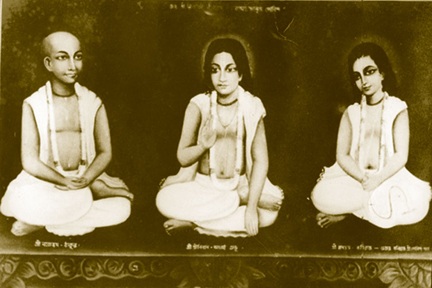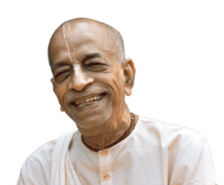
*Srila Narottama Dasa Thakura appearance*
compiled by vijaya murti dasa
Narottama Dasa Thakura also known as Thakura Mahasaya, is a Gaudiya Vaishnava saint who was responsible for spreading Vaishnava bhakti throughout Odisha in and outside of Bengal in India.[1] Narottama dasa was the son of King Krishnananda Datta and Narayani Devi who resided in Gopalpur Pargana of the Rajsahi district of Bangladesh. According to some, after the death of his father he entrusted his royal duties to the eldest paternal uncle’s son and left for Vrindavan.
Biography
Narottama Dasa Thakura was a lifelong brahmachari. He was born in a Kayastha caste family, the son of King Shri Krishnananda Datta, who ruled the area of Gopalpura in Rajashahi district of modern day Bangladesh, his capital being Khetri on the Padma River. Narottama’s mother was Narayani Devi, and he was born on the purnima in the month of Magha (January) 1520 AD.
From Narottama’s early childhood he was always attracted to Shri Chaitanya.When Narottama was born the astrologers came, cast a chart, and said that either this boy will become a great king or a mendicant preacher. He was also trained in Sanskrit which he mastered in a very short time, and for this was very much renowned for his eloquence in the use of Sanskrit grammar, poetry, prosody etc.
At the age of twelve Narottama dasa Thakura had a vision of Lord Nityananda in a dream. He told Narottama to take bath in the Padma River whereupon he would receive love of Godhead. Following the instructions of Lord Nityananda, Narottama bathed in the Padma regardless, and the Goddess of the river appeared and on the order of Lord Chaitanya, gave him pure love of Godhead.
Though still a young man, Narottama das would only maintain himself by observance of the vow of madhukari, which means that he would only eat what he could beg by going from door to door of the householder devotees, just as a bumble bee goes from flower to flower to take pollen. By this strict vow Narottama kept no kitchen or store of foodstuffs. He simply relied only upon the mercy of the Lord.
Narottama dasa Thakura would preach like anything, removing the misconceptions of the age, and would invoke his disciples to follow suit.
This was one of Narottama dasa Thakura’s main preaching points – that a Vaishnava is not a mllecha, nor yavana, nor Brahmin, nor sudra, etc. Vaisnavism should only be gauged according to one’s surrender and realization in Krishna consciousness. There should be no consideration of birth, age, caste, creed, shoe size, education, social status, who one is initiated by, the year one took initiation, or when one first came in contact with devotional service. Nor is Krishna consciousness advancement dependent on household duties, taking sannyasa, ritualistic performances, group agreement, or the like – simply how one is absorbed in one’s service to the lotus eyed Lord. This is the conclusion of Narottama dasa Thakura’s preaching strategy.
Narottama had many thousands of disciples, mostly in the areas of modern day Bangladesh. He departed under the tamarind tree at Prema Ghat by the side of the Ganges (Padma River) at Kheturi, where Lord Chaitanya had sat, and where the goddess of the river presented to Narottama pure love of Godhead, after composing the beautiful song, “Saparsada bhagavad viraha janita vilapa,” which begins “je anilo prema dhana koruna pracur heno prabhu kotha gela acharya thakura.
His life is described in Prema-vilasa. In Vrindavan Narottama was received by Rupa Gosvami and Sanatana Gosvami. After Narottama was initiated by Lokanatha Gosvami who in turn instructed him to go and study from Jiva Goswami. He traveled to Bengal with other sadhus (holy men) to distribute devotional writings to the general public.
Fifty years after the disappearance of Chaitanya Mahaprabhu Narottama organized annual festivals in Bengal, which served to keep the Gaudiya philosophy unified. The significant meeting took place in Kheturi where the Gaudiya Vaishnava Theology of Chaitanya Mahaprabhu’s sect was defined. The exact year of this event is unknown but some say that it was around 1572.[2]
Narottama’s writings
Narottama Dasa is best known for his devotional poetry wherein he describes emotionally intense feelings towards Radha and Krishna. His prayers Shri Rupa Manjari Pada and Shri Guru Carana Padma[3] are still sung in within both Gaudiya Math and ISKCON temples on a regular basis.
Among the writings of Narottama, Prarthana and Premabhakticandrika (The Moonrays of Loving Devotion) are the most well-known.[4] [5]
The brief write-up titled Hatapaltana is also attributed to Narottama but the contents do not seem to be in harmony with historical events and thus some believe that it is a fake work. Narottama did translate Smaranamangala into Bengali verse. In eleven slokas this work describes the pastimes of Radha and Krishna in eight parts of the day.
A. C. Bhaktivedanta Swami Prabhupada, a spiritual descendant of Narottama through Bhaktisiddhanta Sarasvati Thakura, had often cited his prayers as many of Gaudiya Vaishnava acharyas did: “The prayers of Narottama dasa Thakura,” he said. “This sound is above the material platform. It is directly from the spiritual platform. And there is no need of understanding the language. It is just like a thunderburst. Everyone can hear the sound of thunder-there is no misunderstanding. Similarly, these songs are above the material platform, and they crack like thunder within your heart.”
